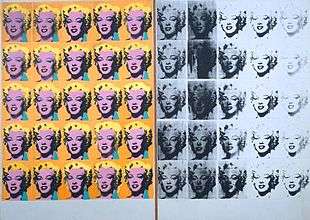Marilyn Diptych
 | |
| Artist | Andy Warhol |
|---|---|
| Year | 1962 |
| Type | Silkscreen |
| Dimensions | 205.44 cm × 289.56 cm (80.88 in × 114.00 in) |
| Location | Tate |
The Marilyn Diptych (1962) is a silkscreen painting by American pop artist Andy Warhol. The piece is one of the artist's most noted works, and it has been praised by several cultural critics such as Camille Paglia and others. The original piece is currently owned by the Tate.
History and analysis
The work was completed during the weeks after Marilyn Monroe's death in August 1962. It contains fifty images of the actress, which are all based on a single publicity photograph from the film Niagara (1953).
The twenty-five pictures on the left side of the diptych are brightly colored, while the twenty-five on the right are in black and white. It has been suggested that the relation between the left side of the canvas and the right side of the canvas is evocative of the relation between the celebrity's life and death.[1][2][3] The work has received praise from writers such as American academic and cultural critic Camille Paglia, who wrote in 2012's Glittering Images lauding how it shows the "multiplicity of meanings" in Monroe's life and legacy.[4]
The piece is currently owned by the Tate. In a December 2, 2004 article in The Guardian, the painting was named the third most influential piece of modern art in a survey of 500 artists, critics, and others.[5] The piece is currently on display at the Tate Modern, as part of the exhibition: Witty, Sexy, Gimmicky: Pop 1957-67.
References
- ↑ Marilyn Diptych. Tate Collection. 2004. Retrieved on September 3, 2008.
- ↑ Helen Gardner, et al. Gardner's Art Through the Ages. Thompson Wadsworth, 2004. 1054.
- ↑ Carol Salus. "Behind the Celestial Enchantment". The Poetry of Life in Literature. Ed. Anna-Teresa Tymieniecka. Springer, 2000. 198.
- ↑ Rosen, Gary (October 16, 2014). "The Pagan Aesthetic". The Wall Street Journal. Retrieved July 17, 2014.
- ↑ Charlotte Higgins. "Work of art that inspired a movement ... a urinal". The Guardian. December 2, 2004. Retrieved on September 3, 2008.